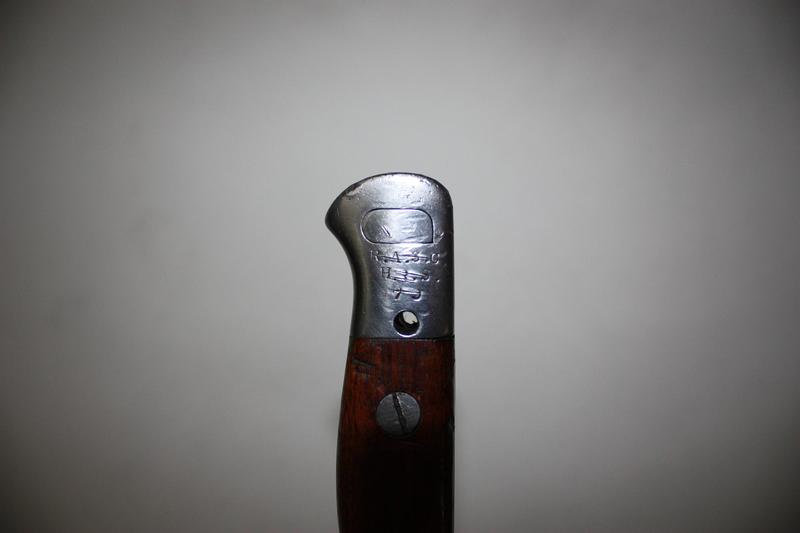-
FREE MEMBER
NO Posting or PM's Allowed

Commercial BSA Nr1 Mk3?
I am new to Lee Enfield and have a question, hopefully someone can help me.
I have bought a Lee Enfield nr1 mk3 which have only the BSA co. mark, no crown date etc.

Uploaded with ImageShack.us
Information
 |
Warning: This is a relatively older thread
This discussion is older than 360 days. Some information contained in it may no longer be current. |
|
Last edited by Toos; 02-14-2011 at 12:23 PM.
-
02-07-2011 09:39 AM
# ADS
Friends and Sponsors

-
Toos,
Where are the other marks, are they on the butt, or the butt disc. any pics?
-
-
-
FREE MEMBER
NO Posting or PM's Allowed

bigduke6, I have added a picture.
-
Advisory Panel


I don't think any BSA commercial rifles were used in WW1. Thus, if the 3.16 refers to March 1916, then the disk has likely been added by a recent owner. If the 3.16 is a divisional marking, then its just possible that the rifle was one of those called into service during WW2 - although by that stage they were not marking butt disks at all.
If the rifle has seen military service, it should show a variety of inspection marks. These will be around the barrel and knox form. Post some pictures if you can, and we may be able to deduce a bit more.
-
-
Legacy Member

Maybe it's the photo, but the info on that disk seems awfully freshly/crisply stamped. And as T'box says, even if commercial rifles were used, they'd have picked up government stampings.
-
-
Deceased January 15th, 2016

If the rifle doesn't have have the Crowned GR mark on the right side of the butt socket, just BSA Co., it was not made for HMG.
The disc is neither here not there compared to those marks.
Last edited by Beerhunter; 02-07-2011 at 01:15 PM.
-
As I understand it, private and 'trade' rifles impressed into service for the war were also re-numbered prior to being issued out. And the original number barred through. Presumably so at the end of hostilities, the original owner could claim it back! This certainly happened with pistols and binoculars and some did indeed get their kit back. My dad certainly got a revolver, a pair of Canadian binoculars, plus a load of new household kit such as sheets and blankets, ironing board, cooking implements etc etc to set up their new home after the war. I don't remember him ever telling me that he donated those things in 1939 or 40 but he certainly took them with him after the war. A sort of lend-lease he used to call it! In fact, when he died, his car tool kit was STILL wrapped up in a Bren spare parts wallet, tucked in the spare wheel of his Vauxhall car!
binoculars, plus a load of new household kit such as sheets and blankets, ironing board, cooking implements etc etc to set up their new home after the war. I don't remember him ever telling me that he donated those things in 1939 or 40 but he certainly took them with him after the war. A sort of lend-lease he used to call it! In fact, when he died, his car tool kit was STILL wrapped up in a Bren spare parts wallet, tucked in the spare wheel of his Vauxhall car!
-
-
Advisory Panel


Toos,
The "Crown over BM" mark is a military view mark that was applied to all of BSA's commercial rifles. See if there are any other marks on the barrel under the handguard.
Try and post a photo of the rifle serial number, and also the serial number on the barrel next to it (right side of chamber). Although BSA used many different number ranges for its commercial rifles, a few number sequences are known to relate to certain contracts.
Since your bayonet is marked to the "RASC", then I would be 99% sure that a previous owner of rifle & bayonet has simply added the "ASC" butt disk in order to create a (badly) matching pair. There would be absolutely zero chance of a rifle and bayonet remaining together when surplussed out - they would have parted company as soon as they were handed in for back-loading by the unit.
-
-
The H?S initials on the bayonet must indicate something but while RASC is definately British Army, those initials don't appear in the 1943 Equipment Regulations (ER's to us.......) that list them. BDL
Army, those initials don't appear in the 1943 Equipment Regulations (ER's to us.......) that list them. BDL has the little booklet copied directly from the ER's if anyone wants to see them.
has the little booklet copied directly from the ER's if anyone wants to see them.
From what I can read there, the regimental initials always seem to appear alongside what sub unit it's from. RASC or ASC on its own could be the RASC or ASC, well, anywhere............ It'd usually be RASC 7Co 39 for 7 Company RASC based at, say, Catterick. Just my twopence worth.....
-
-
Contributing Member


BSA commercial No1 Mk3s, while not used by HMG, are found with South African broad-arrow-in-U marking on the nocks form, indicating use by South African forces either between the wars or during WW2.
-
















 Register To Reply
Register To Reply












